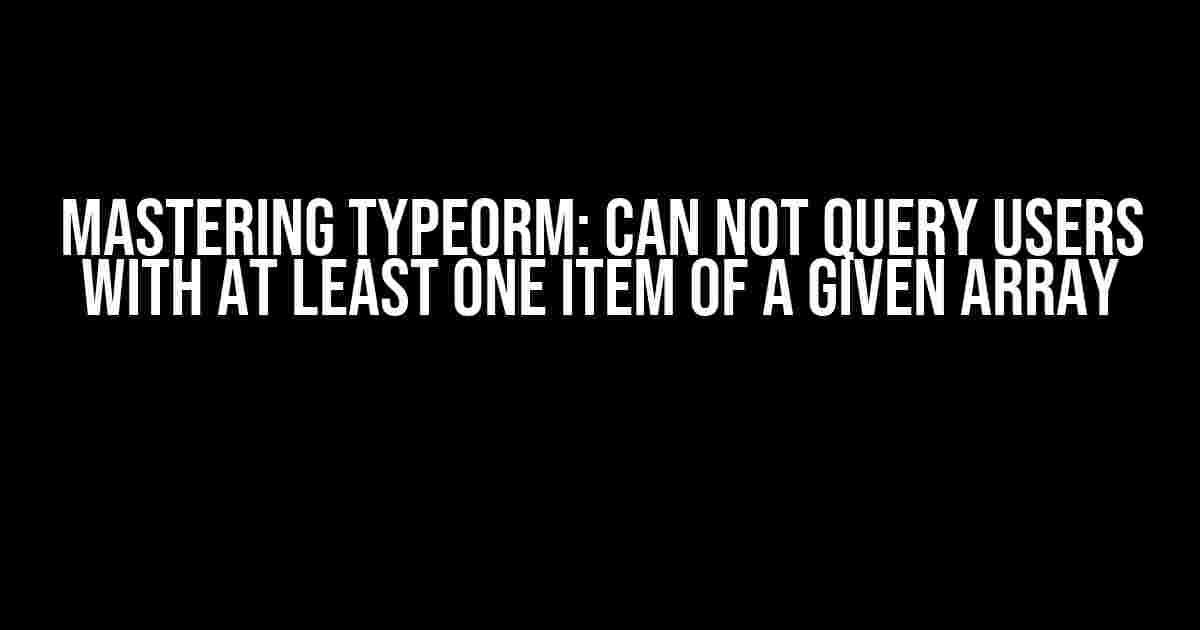Ah, TypeORM! The popular TypeScript ORM that makes interacting with databases a breeze. But, even with its impressive features, you might encounter some hurdles. One common issue developers face is querying users with at least one item of a given array. Sounds tricky? Worry not, dear reader! This article will guide you through the process with ease.
The Problem Statement
Imagine you have a User entity with a many-to-many relationship with an Item entity. You want to retrieve all users who have at least one item from a specific array. Sounds simple, right? However, when trying to achieve this using TypeORM’s QueryBuilder, you might stumble upon the following issue:
const usersWithItems = await getRepository(User)
.createQueryBuilder("user")
.leftJoinAndSelect("user.items", "item")
.where("item.id IN (:...ids)", { ids: [1, 2, 3] }) // ids is an array of item IDs
.getMany();
But, to your surprise, this query returns all users who have all items in the array, not just at least one. What’s going on?
The Reason Behind the Issue
TypeORM’s QueryBuilder uses a simple `IN` operator to filter the results, which is not sufficient for this scenario. To query users with at least one item from the array, we need to use a more advanced approach.
The Solution: Using Subqueries and EXISTS
One way to tackle this issue is by using subqueries and the `EXISTS` clause. Here’s the updated code:
const usersWithItems = await getRepository(User)
.createQueryBuilder("user")
.where(
"EXISTS (
SELECT 1
FROM user_items ui
WHERE ui.userId = user.id
AND ui.itemId IN (:...ids)
)",
{ ids: [1, 2, 3] }
)
.getMany();
In this example, we create a subquery that selects the user IDs that have at least one item from the array. The `EXISTS` clause then filters the results to only include users who have a matching ID in the subquery.
Breaking Down the Subquery
Let’s dissect the subquery to better understand what’s happening:
SELECT 1: We don’t care about the actual values, so we select a constant value (1) to simplify the query.FROM user_items ui: We’re querying the `user_items` table (the many-to-many relationship table).WHERE ui.userId = user.id: We ensure that the user ID in the `user_items` table matches the user ID in the main query.AND ui.itemId IN (:...ids): We filter the results to only include items from the specified array.
Alternative Solution: Using Join and HAVING
Another approach to solve this issue is by using a join and the `HAVING` clause. Here’s the updated code:
const usersWithItems = await getRepository(User)
.createQueryBuilder("user")
.innerJoin("user.items", "item")
.groupBy("user.id")
.having("COUNT(DISTINCT item.id) > 0 AND item.id IN (:...ids)", { ids: [1, 2, 3] })
.getMany();
In this solution, we join the `user` and `item` tables, group the results by user ID, and use the `HAVING` clause to filter the results. The `COUNT(DISTINCT item.id) > 0` part ensures that we only consider users with at least one item, and the `item.id IN (:…ids)` part filters the results to only include users with items from the specified array.
Pros and Cons of Each Solution
Both solutions have their advantages and disadvantages:
| Solution | Pros | Cons |
|---|---|---|
| Subquery with EXISTS | Easy to read and understand, fewer joins required | May be less efficient for large datasets |
| Join with HAVING | Potentially more efficient for large datasets, fewer subqueries | More complex query, harder to read and understand |
Choose the solution that best fits your use case and performance requirements.
Conclusion
Querying users with at least one item of a given array in TypeORM might seem challenging, but with the right approach, it’s achievable. By using subqueries with `EXISTS` or joins with `HAVING`, you can efficiently retrieve the desired results. Remember to consider the pros and cons of each solution and choose the one that best suits your needs.
With this article, you’ve mastered another essential skill in TypeORM. Happy querying!
If you have any questions or need further assistance, feel free to ask in the comments below.
Frequently Asked Question
Got stuck with TypeORM QueryBuilder? Don’t worry, we’ve got you covered! Here are some frequently asked questions and answers about querying users with at least one item of a given array in TypeORM.
Q1: How do I write a query to find users who have at least one item from a given array in TypeORM?
You can use the `any` operator in TypeORM QueryBuilder to achieve this. For example: `repository.createQueryBuilder(‘user’).where(‘user.items @> :items’, { items: [‘item1’, ‘item2’, ‘item3’] }).getMany()`
Q2: What if I want to find users who have all items from the given array?
In that case, you can use the `overlap` operator instead of `any`. For example: `repository.createQueryBuilder(‘user’).where(‘user.items && :items’, { items: [‘item1’, ‘item2’, ‘item3’] }).getMany()`
Q3: Can I use the `in` operator to query users with at least one item from the array?
No, unfortunately, the `in` operator won’t work in this case. The `in` operator is used to check if a value is in a list of values, whereas we need to check if any item in the array is present in the user’s items.
Q4: What if I want to query users who don’t have any items from the given array?
You can use the `NOT` operator in combination with the `any` operator. For example: `repository.createQueryBuilder(‘user’).where(‘NOT user.items @> :items’, { items: [‘item1’, ‘item2’, ‘item3’] }).getMany()`
Q5: Is there a way to query users with at least one item from the array using a subquery?
Yes, you can use a subquery to achieve this. For example: `repository.createQueryBuilder(‘user’).whereExists(repository.createQueryBuilder(‘item’).select(‘1’).from(Item, ‘item’).where(‘item IN (:…items) AND item.user = user.id’)).getMany()`
